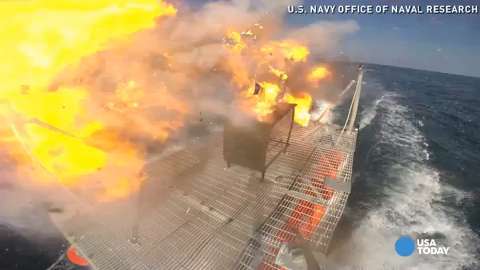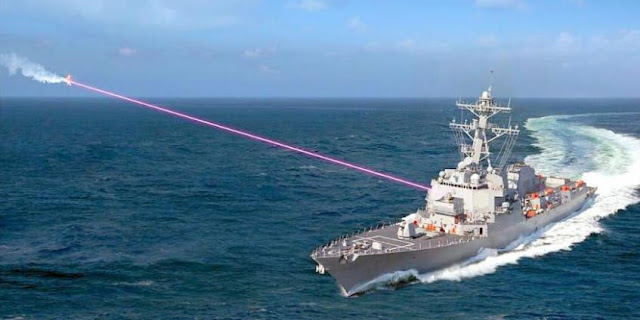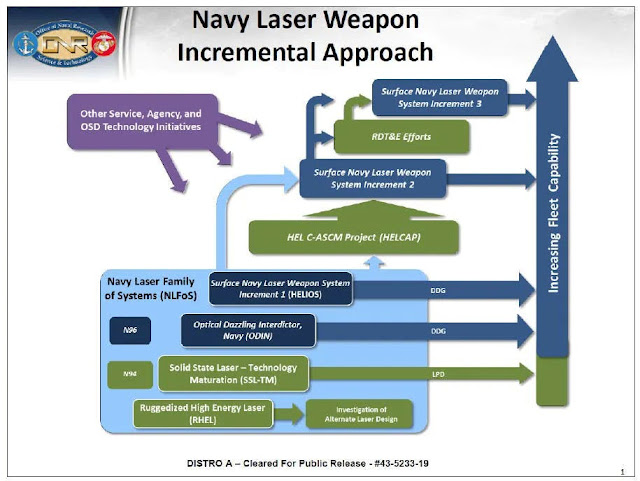L'arrivo delle armi ad energia diretta sulla più recente super portaerei dell’US NAVY, la USS Gerald R. Ford!
La Marina degli Stati Uniti sta cercando di trovare un'alternativa vera per annientare in volo i missili antinave, e la portaerei Gerald R. Ford potrebbe rivelarsi utile in questa ricerca tecnologica.
Una differenza importante tra la Ford ed i suoi predecessori della classe Nimitz è rappresentata dai suoi reattori nucleari gemelli A1B che producono più di tre volte la potenza elettrica dei reattori delle Nimitz: più di 100 megawatt.
Ciò significa che la portaerei Ford, con le problematiche di sopravvivenza che incombono sulle portaerei, è in grado di supportare apparecchiature di grandi dimensioni che consumano tanta energia, come i laser.
La classe FORD è progettata per avere un eccesso di capacità nell’impianto elettrico per portare a bordo i futuri sistemi di armi ad energia diretta.
Ciò è un evidente vantaggio per la nuova classe di portaerei, ed è uno dei motivi per cui la Marina ha progettato la classe Ford nonostante le polemiche sulle nuove tecnologie e gli sforamenti dei costi. La tecnologia della classe Ford è essenziale per la sopravvivenza delle future portaerei, ha detto James Geurts, ufficiale di acquisizione dell’Us Navy: “…la Ford è così importante perché offre la flessibilità necessaria per poter utilizzare la prossima generazione di sistemi atti a garantire che la portaerei possa continuare a sopravvivere", ha detto Geurts.
Bryan Clark, un ufficiale navale in pensione e analista del Center for Strategic and Budgetary Assessments, ha detto che Ford potrebbe utilizzare una spinta nel reparto di sopravvivenza e che i potenti reattori della Ford potrebbero aiutarli ad arrivarci.
"Per migliorare l'autodifesa, si potrebbero mettere dei laser per sostenere quella capacità di autodifesa a corto raggio", ha detto Clark. "Perché il grande problema dei laser in questo momento è la gestione dell'energia. Si può costruire un laser da tre o quattrocento kilowatt, ma per uno di questi bisogna trovare una nave abbastanza grande per metterla in opera e bisogna avere l'energia necessaria per alimentarla. Quindi si ha bisogno di un banco di condensatori ubicato sulla nave o di un generatore abbastanza grande da fornirlo continuamente. Sulla Ford, quello è possibile".
Clark ha sostenuto per anni che la Marina statunitense ha bisogno di allontanarsi dal tentativo di abbattere missili con missili perché un attacco di saturazione da parte di Russia, Cina, Iran, Corea del Nord o chiunque altro possa avere motivo di attaccare una nave della Marina degli Stati Uniti potrebbe costringere un incrociatore o un cacciatorpediniere a spendere tutti i suoi missili e a non sconfiggere la minaccia.
È qui che i missili a corto raggio come il missile Evolved Seasparrow, che può essere impacchettato quattro per cella in un sistema di lancio verticale, e i laser possono avere un grande impatto, anche se ciò significa che la nave debba lasciare che i missili si avvicinino troppo alla nave prima che vengano abbattuti.
"Penso che i laser potrebbero fare la differenza per la classe Ford, perché la tecnologia è già matura; si potrebbero montare sulla nave per affrontare una grande sfida per i vettori, che è la difesa aerea", ha detto Clark. “Si potrebbero mettere sulle nuove unità portaerei diversi laser e dare davvero una spinta alla capacità di difesa d’aerea".
Tuttavia, è improbabile che i laser possano affrontare tutte le minacce poste dai vettori, ha detto Clark.
“I laser sarebbero efficaci contro i missili cruise, fino ad arrivare ai missili cruise supersonici", ha detto Clark. "Naturalmente, le nuove armi ad energia diretta funzionerebbero bene anche contro le piccole imbarcazioni o barchini esplosivi e meno contro i missili ipersonici o i missili balistici”.
La marina statunitense entro il 2021 installerà un’arma laser su alcune navi da guerra della sua flotta. Si tratta di un laser ad alta energia progettato per bruciare barche e abbattere droni senza pilota. L’arma (chiamata HELIOS) andrà in mare tra due anni su un cacciatorpediniere assegnato alla Flotta del Pacifico. La Marina ha effettuato un ordine nel gennaio 2019 dopo il lancio di un bando (il contratto è da 150 milioni di dollari), che è stato aggiudicato dalla Lockheed Martin. La società per il momento ne fornirà due, il secondo finirà nella base militare White Sands Missile Range nel New Mexico per dei test. L’HELIOS oltre a bruciare le imbarcazioni può anche semplicemente “abbagliare” i sensori elettro-ottici di droni mettendoli fuori uso. Quest’ultima funzione può tornare utile per evitare incidenti internazionali con forze straniere. Molte armi già schierate sulle navi da guerra statunitensi, tra cui il sistema Phalanx e il Rolling Airframe Missile (RAM), hanno capacità simili, ma si pensa che HELIOS sia in grado anche di affrontare aerei e missili più grandi e più veloci.
ENGLISH
With laser weapons coming, the US Navy’s newest super carrier has space and power to spare
The U.S. Navy is trying to find an alternative to shooting down anti-ship missiles with other missiles, and the aircraft carrier Gerald R. Ford could prove useful in this pursuit.
A major difference with Ford over its Nimitz-class predecessors is its twin A1B nuclear reactors that produce more than three times the electrical power of the reactors on Nimitz — more than 100 megawatts.
That means Ford, with survivability questions looming over aircraft carriers, can support large, power-sucking equipment such as lasers, according to Capt. J.J. Cummings, the Ford’ commanding officer.
“When you talk about innovation in the Navy, this is where it lives,” Cummings said, referring to his ship. “We’re lighter — designed lighter — than Nimitz class.
“Nimitz class, she’s barreling down pretty good now with a lot of stuff on her, and her electric plant is almost at maximum capacity. We’re light and designed to have excess capacity in our electrical system to bring future systems on board.”
That’s a big advantage for the class, and it’s one of the reasons the Navy has pursued the Ford class despite the controversies over buggy new technology and cost overruns. The Ford class is essential for the survivability of carriers, said James Geurts, the Navy’s top acquisition official.
“Part of the reason Ford is so important is that it gives you the flexibility to generate the next generation of systems you’ll need to ensure the carrier can continue to stay survivable,” Geurts said.
Bryan Clark, a retired naval officer and analyst with the Center for Strategic and Budgetary Assessments, said Ford could use a boost in the survivability department and the Ford’s powerful reactors could help them get there.
“To improve the self-defense on carriers, you could put lasers on there to support that short-range, self-defense capacity,” Clark said. “Because the big problem with lasers right now is power management. You can build a three or four hundred-kilowatt laser, but for one, it’s a big footprint so you have to find a ship big enough to put it on; and two, you have to have the power to actually supply it. So you’re going to need a capacitor bank somewhere on the ship or you need a generator big enough to provide it continuously. On the Ford, you’d get that."
Clark has argued for years that the Navy needs to get away from trying to shoot down missiles with missiles because a saturation attack from Russia, China, Iran, North Korea or anyone else who might have cause to attack a U.S. Navy ship could force a cruiser or destroyer to expend all its missiles and still not have defeated the threat.
That’s where shorter-range missiles such as the Evolved Seasparrow Missile, which can be packed four per cell in a vertical launch system, and lasers can have a big impact, even if it means the ship has to let missiles get uncomfortably close to the ship before it’s taken down.
“I think lasers could make a difference for Ford because the technology is pretty mature, you could fit it on the ship and it would address a big challenge for carriers, which is air defense,” Clark said. “You could put several lasers on there and really give a boost to your air defense capacity.”
However, it’s unlikely lasers could address all threats faced by carriers, Clark said.
“It would be effective for cruise missiles up to maybe the supersonic cruise missiles,” Clark said. “Of course, it would also work against small boats and things like that. It may not work that well against hypersonic missiles or ballistic missiles.”
The U.S. Navy will install a laser weapon on some warships in its fleet by 2021. It is a high-energy laser designed to burn boats and shoot down unmanned drones. The weapon (called HELIOS) will go to sea in two years on a destroyer assigned to the Pacific Fleet. The Navy placed an order in January 2019 after the launch of a tender (the contract is $150 million), which was awarded by Lockheed Martin. The company will provide two for the time being, the second will end up in the White Sands Missile Range military base in New Mexico for testing. HELIOS not only burns the boats but can also simply "dazzle" the electro-optical sensors of drones by knocking them out. The latter function can be useful to avoid international incidents with foreign forces. Many weapons already deployed on U.S. warships, including the Phalanx system and the Rolling Airframe Missile (RAM), have similar capabilities, but HELIOS is also thought to be capable of handling larger and faster aircraft and missiles.
(Web, Google, Wikipedia, defensenews, La Stampa, You Tube)
























































